Explain How Natural Selection Can Lead to Evolution.
Natural Selection and Adaptive Evolution
Natural selection drives adaptive evolution by selecting for and increasing the occurrence of beneficial traits in a population.
Learning Objectives
Explain how natural selection leads to adaptive evolution
Key Takeaways
Key Points
- Natural selection increases or decreases biological traits within a population, thereby selecting for individuals with greater evolutionary fitness.
- An individual with a high evolutionary fitness will provide more beneficial contributions to the gene pool of the next generation.
- Relative fitness, which compares an organism's fitness to the others in the population, allows researchers to establish how a population may evolve by determining which individuals are contributing additional offspring to the next generation.
- Stabilizing selection, directional selection, diversifying selection, frequency -dependent selection, and sexual selection all contribute to the way natural selection can affect variation within a population.
Key Terms
- natural selection: a process in which individual organisms or phenotypes that possess favorable traits are more likely to survive and reproduce
- fecundity: number, rate, or capacity of offspring production
- Darwinian fitness: the average contribution to the gene pool of the next generation that is made by an average individual of the specified genotype or phenotype
An Introduction to Adaptive Evolution
Natural selection only acts on the population's heritable traits: selecting for beneficial alleles and, thus, increasing their frequency in the population, while selecting against deleterious alleles and, thereby, decreasing their frequency. This process is known as adaptive evolution. Natural selection does not act on individual alleles, however, but on entire organisms. An individual may carry a very beneficial genotype with a resulting phenotype that, for example, increases the ability to reproduce ( fecundity ), but if that same individual also carries an allele that results in a fatal childhood disease, that fecundity phenotype will not be passed on to the next generation because the individual will not live to reach reproductive age. Natural selection acts at the level of the individual; it selects for individuals with greater contributions to the gene pool of the next generation, known as an organism's evolutionary fitness (or Darwinian fitness).
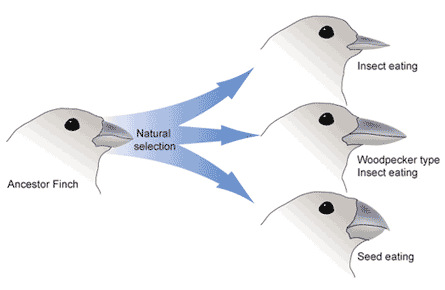
Adaptive evolution in finches: Through natural selection, a population of finches evolved into three separate species by adapting to several difference selection pressures. Each of the three modern finches has a beak adapted to its life history and diet.
Fitness is often quantifiable and is measured by scientists in the field. However, it is not the absolute fitness of an individual that counts, but rather how it compares to the other organisms in the population. This concept, called relative fitness, allows researchers to determine which individuals are contributing additional offspring to the next generation and, thus, how the population might evolve.
There are several ways selection can affect population variation:
- stabilizing selection
- directional selection
- diversifying selection
- frequency-dependent selection
- sexual selection
As natural selection influences the allele frequencies in a population, individuals can either become more or less genetically similar and the phenotypes displayed can become more similar or more disparate. In the end, natural selection cannot produce perfect organisms from scratch, it can only generate populations that are better adapted to survive and successfully reproduce in their environments through the aforementioned selections.
Galápagos with David Attenborough: Two hundred years after Charles Darwin set foot on the shores of the Galápagos Islands, David Attenborough travels to this wild and mysterious archipelago. Amongst the flora and fauna of these enchanted volcanic islands, Darwin formulated his groundbreaking theories on evolution. Journey with Attenborough to explore how life on the islands has continued to evolve in biological isolation, and how the ever-changing volcanic landscape has given birth to species and sub-species that exist nowhere else in the world.
Stabilizing, Directional, and Diversifying Selection
Stabilizing, directional, and diversifying selection either decrease, shift, or increase the genetic variance of a population.
Learning Objectives
Contrast stabilizing selection, directional selection, and diversifying selection.
Key Takeaways
Key Points
- Stabilizing selection results in a decrease of a population 's genetic variance when natural selection favors an average phenotype and selects against extreme variations.
- In directional selection, a population's genetic variance shifts toward a new phenotype when exposed to environmental changes.
- Diversifying or disruptive selection increases genetic variance when natural selection selects for two or more extreme phenotypes that each have specific advantages.
- In diversifying or disruptive selection, average or intermediate phenotypes are often less fit than either extreme phenotype and are unlikely to feature prominently in a population.
Key Terms
- directional selection: a mode of natural selection in which a single phenotype is favored, causing the allele frequency to continuously shift in one direction
- disruptive selection: (or diversifying selection) a mode of natural selection in which extreme values for a trait are favored over intermediate values
- stabilizing selection: a type of natural selection in which genetic diversity decreases as the population stabilizes on a particular trait value
Stabilizing Selection
If natural selection favors an average phenotype by selecting against extreme variation, the population will undergo stabilizing selection. For example, in a population of mice that live in the woods, natural selection will tend to favor individuals that best blend in with the forest floor and are less likely to be spotted by predators. Assuming the ground is a fairly consistent shade of brown, those mice whose fur is most-closely matched to that color will most probably survive and reproduce, passing on their genes for their brown coat. Mice that carry alleles that make them slightly lighter or slightly darker will stand out against the ground and will more probably die from predation. As a result of this stabilizing selection, the population's genetic variance will decrease.

Stabilizing selection: Stabilizing selection occurs when the population stabilizes on a particular trait value and genetic diversity decreases.
Directional Selection
When the environment changes, populations will often undergo directional selection, which selects for phenotypes at one end of the spectrum of existing variation.
A classic example of this type of selection is the evolution of the peppered moth in eighteenth- and nineteenth-century England. Prior to the Industrial Revolution, the moths were predominately light in color, which allowed them to blend in with the light-colored trees and lichens in their environment. As soot began spewing from factories, the trees darkened and the light-colored moths became easier for predatory birds to spot.

Directional selection: Directional selection occurs when a single phenotype is favored, causing the allele frequency to continuously shift in one direction.
Over time, the frequency of the melanic form of the moth increased because their darker coloration provided camouflage against the sooty tree; they had a higher survival rate in habitats affected by air pollution. Similarly, the hypothetical mouse population may evolve to take on a different coloration if their forest floor habitat changed. The result of this type of selection is a shift in the population's genetic variance toward the new, fit phenotype.
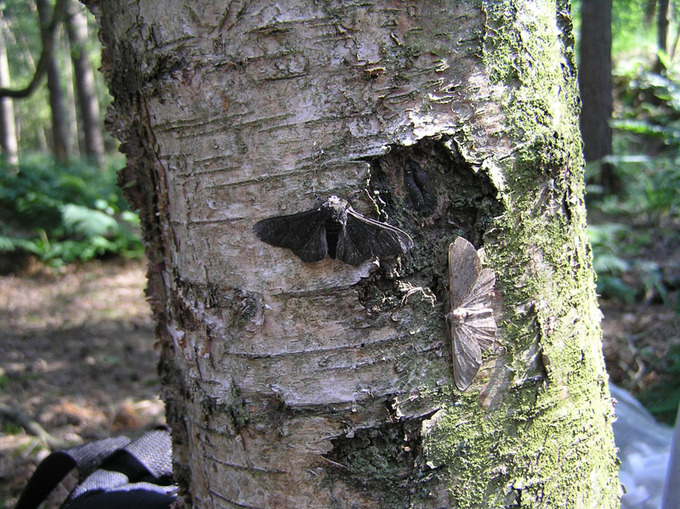
The Evolution of the Peppered Moth: Typica and carbonaria morphs resting on the same tree.The light-colored typica (below the bark's scar) is nearly invisible on this pollution-free tree, camouflaging it from predators.
Diversifying (or Disruptive) Selection
Sometimes natural selection can select for two or more distinct phenotypes that each have their advantages. In these cases, the intermediate phenotypes are often less fit than their extreme counterparts. Known as diversifying or disruptive selection, this is seen in many populations of animals that have multiple male mating strategies, such as lobsters. Large, dominant alpha males obtain mates by brute force, while small males can sneak in for furtive copulations with the females in an alpha male's territory. In this case, both the alpha males and the "sneaking" males will be selected for, but medium-sized males, which cannot overtake the alpha males and are too big to sneak copulations, are selected against.

Diversifying (or disruptive) selection: Diversifying selection occurs when extreme values for a trait are favored over the intermediate values.This type of selection often drives speciation.
Diversifying selection can also occur when environmental changes favor individuals on either end of the phenotypic spectrum. Imagine a population of mice living at the beach where there is light-colored sand interspersed with patches of tall grass. In this scenario, light-colored mice that blend in with the sand would be favored, as well as dark-colored mice that can hide in the grass. Medium-colored mice, on the other hand, would not blend in with either the grass or the sand and, thus, would more probably be eaten by predators. The result of this type of selection is increased genetic variance as the population becomes more diverse.
Comparing Types of Natural Selection
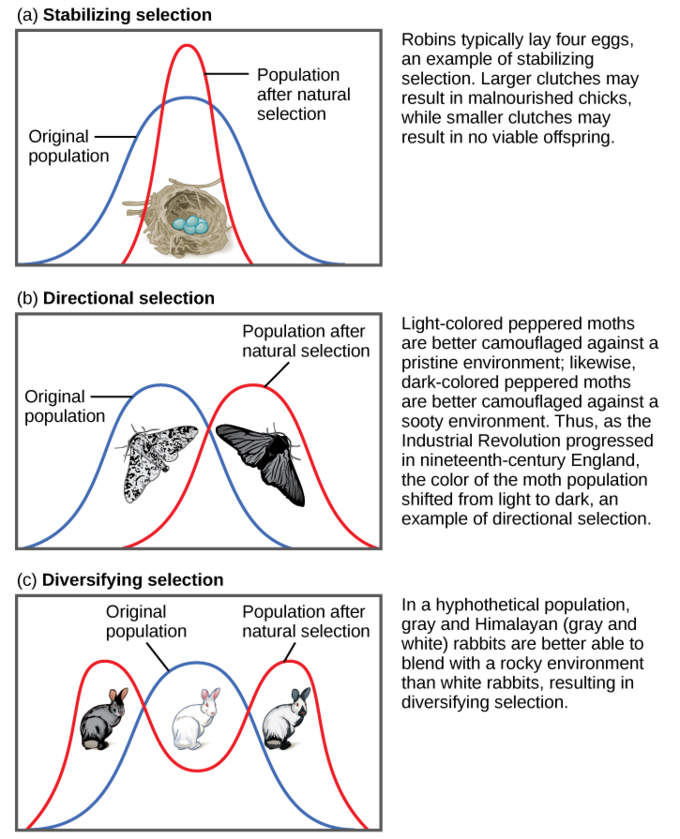
Types of natural selection: Different types of natural selection can impact the distribution of phenotypes within a population.In (a) stabilizing selection, an average phenotype is favored.In (b) directional selection, a change in the environment shifts the spectrum of phenotypes observed.In (c) diversifying selection, two or more extreme phenotypes are selected for, while the average phenotype is selected against.
Frequency-Dependent Selection
In frequency-dependent selection, phenotypes that are either common or rare are favored through natural selection.
Learning Objectives
Describe frequency-dependent selection
Key Takeaways
Key Points
- Negative frequency -dependent selection selects for rare phenotypes in a population and increases a population's genetic variance.
- Positive frequency-dependent selection selects for common phenotypes in a population and decreases genetic variance.
- In the example of male side-blotched lizards, populations of each color pattern increase or decrease at various stages depending on their frequency; this ensures that both common and rare phenotypes continue to be cyclically present.
- Infectious agents such as microbes can exhibit negative frequency-dependent selection; as a host population becomes immune to a common strain of the microbe, less common strains of the microbe are automatically favored.
- Variation in color pattern mimicry by the scarlet kingsnake is dependent on the prevalence of the eastern coral snake, the model for this mimicry, in a particular geographical region. The more prevalent the coral snake is in a region, the more common and variable the scarlet kingsnake's color pattern will be, making this an example of positive frequency-dependent selection.
Key Terms
- frequency-dependent selection: the term given to an evolutionary process where the fitness of a phenotype is dependent on its frequency relative to other phenotypes in a given population
- polygynous: having more than one female as mate
Frequency-dependent Selection
Another type of selection, called frequency-dependent selection, favors phenotypes that are either common (positive frequency-dependent selection) or rare (negative frequency-dependent selection).
Negative Frequency-dependent Selection
An interesting example of this type of selection is seen in a unique group of lizards of the Pacific Northwest. Male common side-blotched lizards come in three throat-color patterns: orange, blue, and yellow. Each of these forms has a different reproductive strategy: orange males are the strongest and can fight other males for access to their females; blue males are medium-sized and form strong pair bonds with their mates; and yellow males are the smallest and look a bit like female, allowing them to sneak copulations. Like a game of rock-paper-scissors, orange beats blue, blue beats yellow, and yellow beats orange in the competition for females. The big, strong orange males can fight off the blue males to mate with the blue's pair-bonded females; the blue males are successful at guarding their mates against yellow sneaker males; and the yellow males can sneak copulations from the potential mates of the large, polygynous orange males.
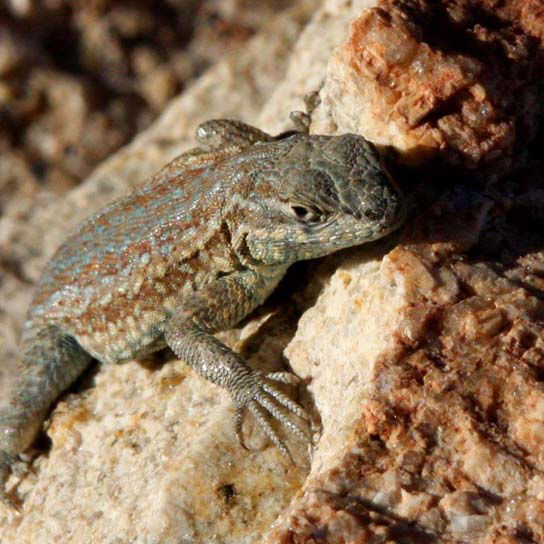
Frequency-dependent selection in side-blotched lizards: A yellow-throated side-blotched lizard is smaller than either the blue-throated or orange-throated males and appears a bit like the females of the species, allowing it to sneak copulations. Frequency-dependent selection allows for both common and rare phenotypes of the population to appear in a frequency-aided cycle.
In this scenario, orange males will be favored by natural selection when the population is dominated by blue males, blue males will thrive when the population is mostly yellow males, and yellow males will be selected for when orange males are the most populous. As a result, populations of side-blotched lizards cycle in the distribution of these phenotypes. In one generation, orange might be predominant and then yellow males will begin to rise in frequency. Once yellow males make up a majority of the population, blue males will be selected for.Finally, when blue males become common, orange males will once again be favored.
An example of negative frequency-dependent selection can also be seen in the interaction between the human immune system and various infectious microbes such as pathogenic bacteria or viruses. As a particular human population is infected by a common strain of microbe, the majority of individuals in the population become immune to it. This then selects for rarer strains of the microbe which can still infect the population because of genome mutations; these strains have greater evolutionary fitness because they are less common.
Positive Frequency-dependent Selection
An example of positive frequency-dependent selection is the mimicry of the warning coloration of dangerous species of animals by other species that are harmless. The scarlet kingsnake, a harmless species, mimics the coloration of the eastern coral snake, a venomous species typically found in the same geographical region. Predators learn to avoid both species of snake due to the similar coloration, and as a result the scarlet kingsnake becomes more common, and its coloration phenotype becomes more variable due to relaxed selection. This phenotype is therefore more "fit" as the population of species that possess it (both dangerous and harmless) becomes more numerous. In geographic areas where the coral snake is less common, the pattern becomes less advantageous to the kingsnake, and much less variable in its expression, presumably because predators in these regions are not "educated" to avoid the pattern.

Lampropeltis elapsoides, the scarlet kingsnake: The scarlet kingsnake mimics the coloration of the poisonous eastern coral snake. Positive frequency-dependent selection reinforces the common phenotype because predators avoid the distinct coloration.

Micrurus fulvius, the eastern coral snake: The eastern coral snake is poisonous.
Negative frequency-dependent selection serves to increase the population's genetic variance by selecting for rare phenotypes, whereas positive frequency-dependent selection usually decreases genetic variance by selecting for common phenotypes.
Sexual Selection
Sexual selection, the selection pressure on males and females to obtain matings, can result in traits designed to maximize sexual success.
Learning Objectives
Discuss the effects of sexual dimorphism on the reproductive potential of an organism
Key Takeaways
Key Points
- Sexual selection often results in the development of secondary sexual characteristics, which help to maximize a species ' reproductive success, but do not provide any survival benefits.
- The handicap principle states that only the best males survive the risks from traits that may actually be detrimental to a species; therefore, they are more fit as mating partners.
- In the good genes hypothesis, females will choose males that show off impressive traits to ensure they pass on genetic superiority to their offspring.
- Sexual dimorphisms, obvious morphological differences between the sexes of a species, arise when there is more variance in the reproductive success of either males or females.
Key Terms
- sexual dimorphism: a physical difference between male and female individuals of the same species
- sexual selection: a type of natural selection, where members of the sexes acquire distinct forms because members choose mates with particular features or because competition for mates with certain traits succeed
- handicap principle: a theory that suggests that animals of greater biological fitness signal this status through a behavior or morphology that effectively lowers their chances of survival
Sexual Selection
The selection pressures on males and females to obtain matings is known as sexual selection. Sexual selection takes two major forms: intersexual selection (also known as 'mate choice' or 'female choice') in which males compete with each other to be chosen by females; and intrasexual selection (also known as 'male–male competition') in which members of the less limited sex (typically males) compete aggressively among themselves for access to the limiting sex. The limiting sex is the sex which has the higher parental investment, which therefore faces the most pressure to make a good mate decision.
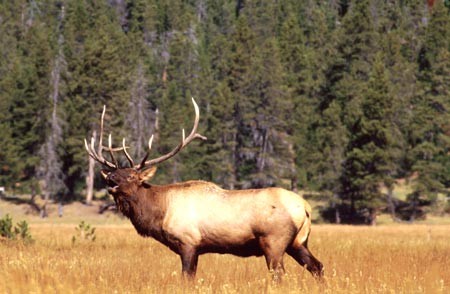
Sexual selection in elk: This male elk has large antlers to compete with rival males for available females (intrasexual competition).Tn addition, the many points on his antlers represent health and longevity, and therefore he may be more desirable to females (intersexual selection).
Sexual Dimorphism
Males and females of certain species are often quite different from one another in ways beyond the reproductive organs. Males are often larger, for example, and display many elaborate colors and adornments, such as the peacock's tail, while females tend to be smaller and duller in decoration. These differences are called sexual dimorphisms and arise from the variation in male reproductive success.
Females almost always mate, while mating is not guaranteed for males. The bigger, stronger, or more decorated males usually obtain the vast majority of the total matings, while other males receive none. This can occur because the males are better at fighting off other males, or because females will choose to mate with the bigger or more decorated males. In either case, this variation in reproductive success generates a strong selection pressure among males to obtain those matings, resulting in the evolution of bigger body size and elaborate ornaments in order to increase their chances of mating. Females, on the other hand, tend to get a handful of selected matings; therefore, they are more likely to select more desirable males.

Sexual dimorphism: Morphological differences between males and females of the same species is known as sexual dimorphism.These differences can be observed in (a) peacocks and peahens, (b) Argiope appensa spiders (the female spider is the large one), and (c) wood ducks.
Sexual dimorphism varies widely among species; some species are even sex-role reversed. In such cases, females tend to have a greater variation in their reproductive success than males and are, correspondingly, selected for the bigger body size and elaborate traits usually characteristic of males.
The Handicap Principle
Sexual selection can be so strong that it selects for traits that are actually detrimental to the individual's survival, even though they maximize its reproductive success. For example, while the male peacock's tail is beautiful and the male with the largest, most colorful tail will more probably win the female, it is not a practical appendage. In addition to being more visible to predators, it makes the males slower in their attempted escapes. There is some evidence that this risk, in fact, is why females like the big tails in the first place. Because large tails carry risk, only the best males survive that risk and therefore the bigger the tail, the more fit the male. This idea is known as the handicap principle.
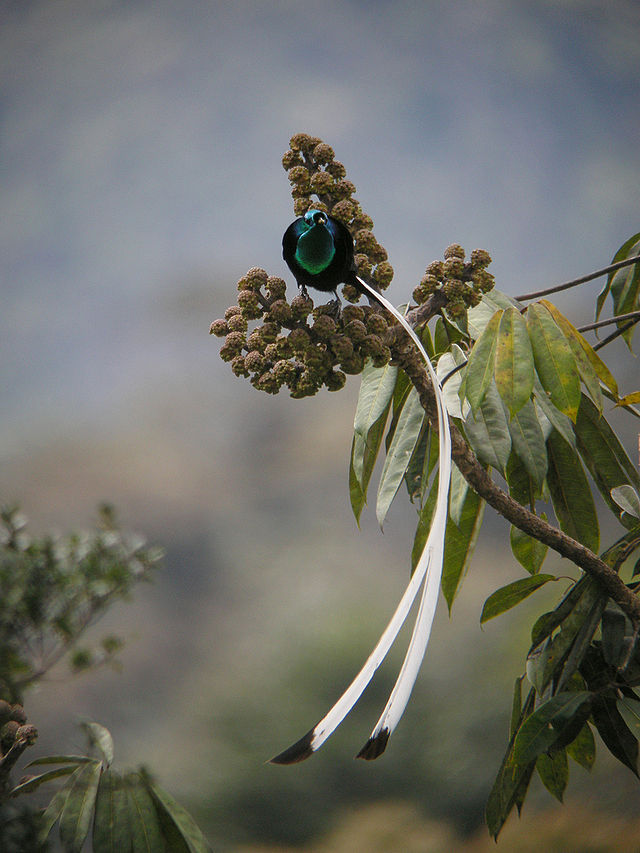
A male bird of paradise: This male bird of paradise carries an extremely long tail as the result of sexual selection.The tail is flamboyant and detrimental to the bird's own survival, but it increases his reproductive success.This may be an example of the handicap principle.
The Good Genes Hypothesis
The good genes hypothesis states that males develop these impressive ornaments to show off their efficient metabolism or their ability to fight disease. Females then choose males with the most impressive traits because it signals their genetic superiority, which they will then pass on to their offspring. Though it might be argued that females should not be so selective because it will likely reduce their number of offspring, if better males father more fit offspring, it may be beneficial. Fewer, healthier offspring may increase the chances of survival more than many, weaker offspring.
BBC Planet Earth – Birds of Paradise mating dance: Extraordinary Courtship displays from these weird and wonderful creatures. From episode 1 "Pole to Pole". This is an example of the extreme behaviors that arise from intense sexual selection pressure.
No Perfect Organism
Natural selection cannot create novel, perfect species because it only selects on existing variations in a population.
Learning Objectives
Explain the limitations encountered in natural selection
Key Takeaways
Key Points
- Natural selection is limited by a population 's existing genetic variation.
- Natural selection is limited through linkage disequilibrium, where alleles that are physically proximate on the chromosome are passed on together at greater frequencies.
- In a polymorphic population, two phenotypes may be maintained in the population despite the higher fitness of one morph if the intermediate phenotype is detrimental.
- Evolution is not purposefully adaptive; it is the result of various selection forces working together to influence genetic and phenotypical variances within a population.
Key Terms
- linkage disequilibrium: a non-random association of two or more alleles at two or more loci; normally caused by an interaction between genes
- genetic hitchhiking: changes in the frequency of an allele because of linkage with a positively or negatively selected allele at another locus
- polymorphism: the regular existence of two or more different genotypes within a given species or population
No Perfect Organism
Natural selection is a driving force in evolution and can generate populations that are adapted to survive and successfully reproduce in their environments. However, natural selection cannot produce the perfect organism. Natural selection can only select on existing variation in the population; it cannot create anything from scratch. Therefore, the process of evolution is limited by a population's existing genetic variance, the physical proximity of alleles, non-beneficial intermediate morphs in a polymorphic population, and non-adaptive evolutionary forces.
Natural Selection Acts on Individuals, not Alleles
Natural selection is also limited because it acts on the phenotypes of individuals, not alleles. Some alleles may be more likely to be passed on with alleles that confer a beneficial phenotype because of their physical proximity on the chromosomes. Alleles that are carried together are in linkage disequilibrium. When a neutral allele is linked to beneficial allele, consequently meaning that it has a selective advantage, the allele frequency can increase in the population through genetic hitchhiking (also called genetic draft).
Any given individual may carry some beneficial alleles and some unfavorable alleles. Natural selection acts on the net effect of these alleles and corresponding fitness of the phenotype. As a result, good alleles can be lost if they are carried by individuals that also have several overwhelmingly bad alleles; similarly, bad alleles can be kept if they are carried by individuals that have enough good alleles to result in an overall fitness benefit.
Polymorphism
Furthermore, natural selection can be constrained by the relationships between different polymorphisms. One morph may confer a higher fitness than another, but may not increase in frequency because the intermediate morph is detrimental.

Polymorphism in the grove snail: Color and pattern morphs of the grove snail, Cepaea nemoralis.The polymorphism, when two or more different genotypes exist within a given species, in grove snails seems to have several causes, including predation by thrushes.
For example, consider a hypothetical population of mice that live in the desert. Some are light-colored and blend in with the sand, while others are dark and blend in with the patches of black rock. The dark-colored mice may be more fit than the light-colored mice, and according to the principles of natural selection the frequency of light-colored mice is expected to decrease over time. However, the intermediate phenotype of a medium-colored coat is very bad for the mice: these cannot blend in with either the sand or the rock and will more vulnerable to predators. As a result, the frequency of a dark-colored mice would not increase because the intermediate morphs are less fit than either light-colored or dark-colored mice. This a common example of disruptive selection.
Not all Evolution is Adaptive
Finally, it is important to understand that not all evolution is adaptive. While natural selection selects the fittest individuals and often results in a more fit population overall, other forces of evolution, including genetic drift and gene flow, often do the opposite by introducing deleterious alleles to the population's gene pool. Evolution has no purpose. It is not changing a population into a preconceived ideal. It is simply the sum of various forces and their influence on the genetic and phenotypic variance of a population.
Explain How Natural Selection Can Lead to Evolution.
Source: https://courses.lumenlearning.com/boundless-biology/chapter/adaptive-evolution/